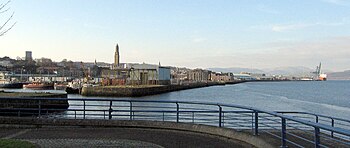
A burgh of barony is a type of Scottish town (burgh).
They were distinct from royal burghs as the title was granted to a tenant-in-chief, a landowner who held his estates directly from the crown. (In distinction, burghs of regality were granted to "lords of regality", leading noblemen, and had wider civil and criminal law powers). They were created between 1450 and 1707, and conferred upon the landowner varying trading rights (for example the right to hold weekly markets or to trade overseas). In practice very few burghs of barony developed into market towns.
Over 300 burghs of barony and regality were created: the last was Ardrossan in 1846. From 1833 inhabitants of such burghs could form a police burgh governed by elected commissioners. In some cases the existing burgh continued to exist alongside the police burgh. Remaining burghs of barony and regality were abolished in 1893 by the Burgh Police (Scotland) Act, 1892. Where a police burgh had been formed it absorbed the burgh of barony, in other cases the burgh was dissolved. From that date there was no practical difference between burghs of barony and other police burghs, though a distinction was still sometimes made. For instance, in 1957 Lord Lyon introduced distinctive "burghal coronets" to be displayed above the arms of burghs matriculated by his office: a "coronet suitable to a burgh of barony" was a red mural crown, whereas that for a police burgh was blue in colour.
All burghs were abolished in 1975 by the Local Government (Scotland) Act 1973. The titles are therefore redundant today although they remain in descriptive use.
No comments:
Post a Comment